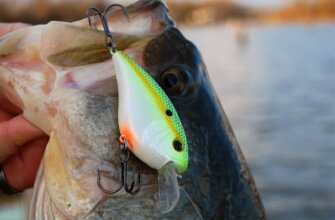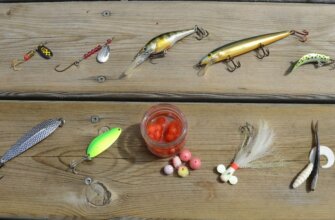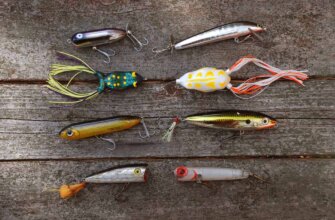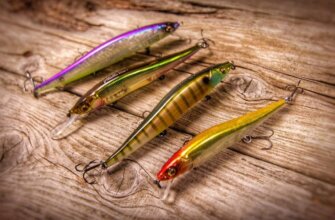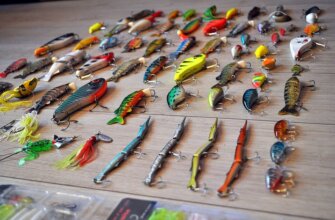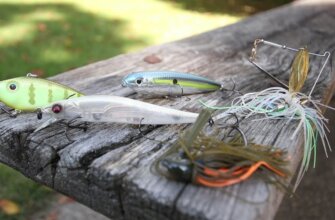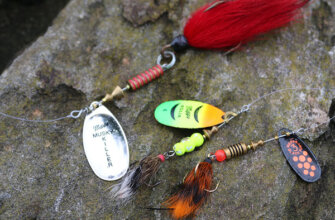Musky lures are artificial fishing baits specifically designed to attract and catch muskellunge, a large predatory fish found in freshwater lakes and rivers in North America. Muskies, as they are commonly called, are known as the “fish of 10,000 casts” due to their elusive nature and the challenges associated with catching them.
Muskellunge are voracious predators and are known for their aggressive strikes, making them a popular target for anglers seeking a thrilling fishing experience. Musky lures are designed to mimic the appearance and behavior of the muskie’s natural prey, such as smaller fish, frogs, or even small mammals. These lures come in a wide variety of shapes, sizes, colors, and styles to cater to different fishing conditions and angler preferences.
10 best musky lures
Here are 10 popular musky lures that are often recommended by anglers:
- Bulldawg. The Bulldawg is a soft plastic lure with a durable, lifelike body and a single treble hook. Its swimming action and realistic appearance make it a go-to lure for many musky anglers.
- Suick Thriller. The Suick Thriller is a wooden jerkbait that imitates injured baitfish. It has a side-to-side gliding action and is known for triggering aggressive strikes from muskies.
- Bucher TopRaider. The Bucher TopRaider is a topwater lure that creates a loud, churning surface disturbance. Its propeller blades attract muskies by creating noise and commotion.
- Mepps Musky Killer. The Mepps Musky Killer is a spinnerbait that combines a bucktail skirt with a large spinner blade. It produces flash and vibration to entice muskies into striking.
- Grandma Lures. Grandma Lures are known for their wide, wobbling action. These large crankbaits come in various colors and are effective for covering a lot of water.
- Believer. The Believer is a jointed swimbait with a realistic fish-like appearance. It has a slow, wide-sweeping action that muskies find irresistible.
- Medussa. The Medussa is a soft plastic bait with multiple tails that create a unique swimming action. Its soft body provides a lifelike feel, and its large profile attracts big muskies.
- Phantom Softail. The Phantom Softail is a glide bait that mimics the movement of live fish. It has a slender profile and a natural, gliding action that muskies find enticing.
- Weagle. The Weagle is a topwater bait designed to create a side-to-side “walk the dog” action. It is effective in calm water conditions and can trigger explosive strikes from muskies.
- Shallow Invader. The Shallow Invader is a shallow-running crankbait that excels in weed beds and shallow structures. Its diving depth and realistic swimming action make it a reliable musky lure.
Bulldawg
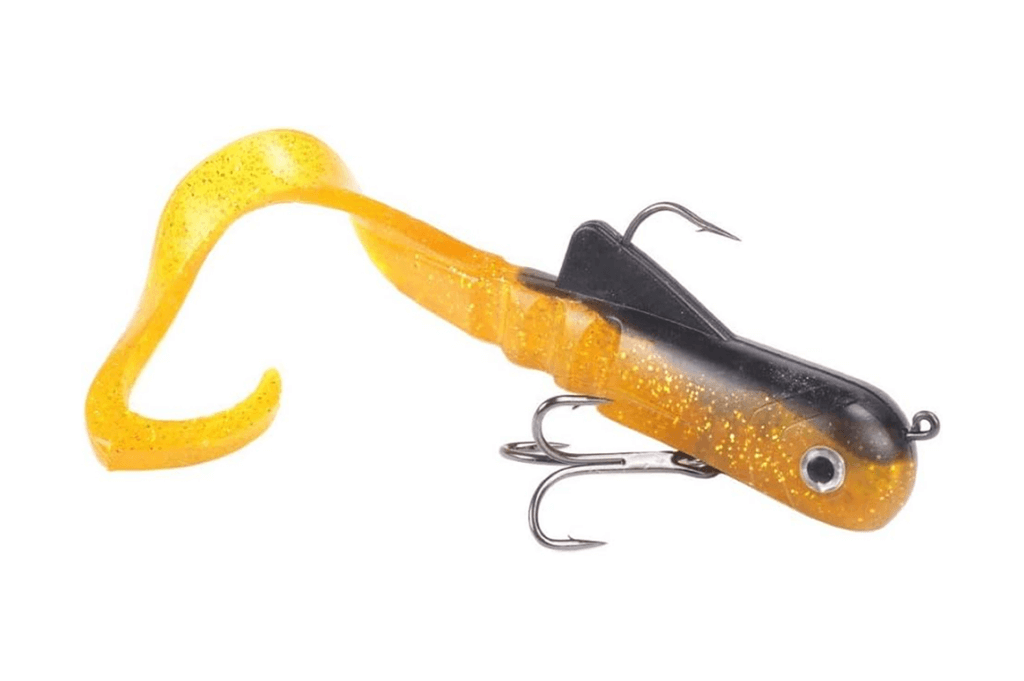
The Bulldawg lure is a popular choice among musky anglers. It is a soft plastic bait designed to imitate a wounded or struggling fish, making it an enticing target for musky.
The Bulldawg features a long, segmented body with a durable tail that produces lifelike swimming action in the water. It often comes with multiple treble hooks attached to ensure a higher chance of hooking musky when they strike.
To use the Bulldawg lure for musky fishing, cast it out and retrieve it with a combination of steady reeling and occasional pauses. The realistic swimming action of the lure can attract musky from a distance, and the pauses can imitate the behavior of injured prey, triggering aggressive strikes.
The Bulldawg comes in various sizes and colors, allowing anglers to match the local musky’s preferences and the fishing conditions. It is commonly used in larger sizes to target trophy-sized musky.
When fishing with the Bulldawg, it is important to use heavy-duty tackle and a strong fishing line to handle the powerful strikes and potential fights with musky. Proper handling and safe hook removal are crucial when catching and releasing musky.
The Bulldawg is specifically designed for musky, but it can also attract other predatory fish species, such as pike and large bass. It is suitable for fishing in lakes, rivers, and reservoirs where musky are known to inhabit.
| Advantages | Disadvantages |
| Versatility: Bulldawg lures are known for their versatility, as they can be used in various fishing conditions and water types. They are effective in both clear and murky waters and can be used at different depths. Attraction: These lures are designed to mimic the appearance and movement of baitfish, which can be highly enticing to predatory fish. The lifelike action and vibrant colors of Bulldawg lures can attract aggressive strikes from muskie, pike, and other similar species. Durability: Bulldawg lures are often made from durable materials, such as soft plastic or rubber, which can withstand the sharp teeth of predatory fish. This durability means they can endure multiple strikes and remain effective over time. Customization: Bulldawg lures often come with interchangeable tails or blades, allowing anglers to customize the lure’s action and profile to suit different fishing situations. This versatility can increase the chances of attracting fish. | Price: Compared to some other fishing lures, Bulldawg lures can be relatively expensive. Their construction, design, and material quality contribute to the higher cost. This may make them less accessible to anglers on a tight budget. Learning Curve: Bulldawg lures require a specific technique to maximize their effectiveness. Anglers need to learn how to manipulate the lure to create the desired action and mimic the movement of baitfish. This learning curve can be challenging for beginners. Snagging: Due to their multiple hooks and appendages, Bulldawg lures can be prone to snagging on vegetation or underwater structures. This can lead to frustration and lost lures. Anglers need to be cautious when fishing in areas with dense cover or debris. Limited Species: While Bulldawg lures are highly effective for targeting muskie, pike, and other predatory fish, they may not be as successful for other species. Their size and action may not attract smaller or more passive fish, limiting their versatility in certain fishing scenarios. |
Suick Thriller
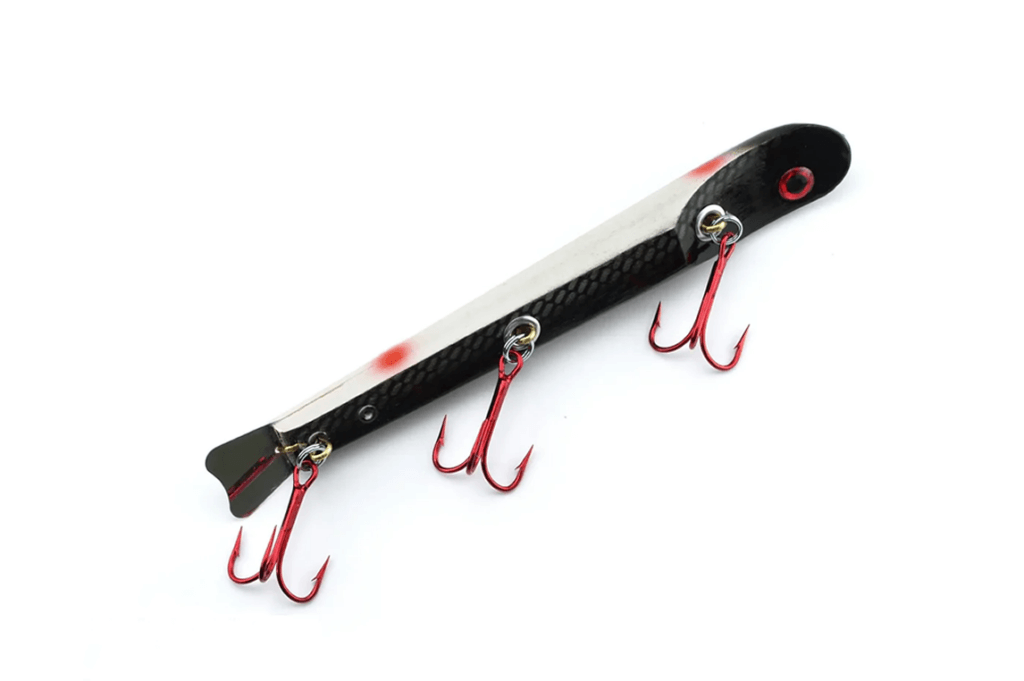
The Suick Thriller is a highly regarded lure among musky anglers. It is a hard-bodied, jointed bait designed to imitate a wounded or fleeing baitfish, making it a tempting target for musky.
The Suick Thriller features a segmented body with a lifelike profile and realistic swimming action. It is often equipped with multiple treble hooks to increase the chances of hooking musky when they strike.
To use the Suick Thriller for musky fishing, cast it out and retrieve it with a combination of steady reeling, twitching, and jerking motions. The erratic movements and realistic swimming action of the lure can trigger the predatory instincts of musky, enticing them to strike.
The Suick Thriller comes in various sizes and color patterns, allowing anglers to match the local musky’s preferences and the fishing conditions. It is commonly used in larger sizes to target trophy-sized musky.
When fishing with the Suick Thriller, it is important to use heavy-duty tackle and a strong fishing line to handle the powerful strikes and potential fights with musky. Proper handling and safe hook removal are crucial when catching and releasing musky.
The Suick Thriller is specifically designed for musky, but it can also attract other predatory fish species, such as pike and large bass. It is suitable for fishing in lakes, rivers, and reservoirs where musky are known to inhabit.
| Advantages | Disadvantages |
| Versatility: The Suick Thriller is a versatile lure that can be used in various fishing conditions and water types. It can be effective in both clear and murky waters and is designed to target predatory fish like muskie, pike, and large bass. Lifelike Action: The Suick Thriller is known for its realistic and enticing action. Its unique design allows for a side-to-side “walk-the-dog” motion when retrieved, mimicking the erratic movement of wounded baitfish. This action can trigger aggressive strikes from muskie and other predators. Durability: Suick Thrillers are typically built to be durable and withstand the sharp teeth and strong jaws of muskie and other large fish. They are constructed from tough materials like hard plastic or wood, making them resistant to damage caused by repeated strikes or toothy encounters. Attraction: The Suick Thriller’s realistic appearance and lifelike action make it a highly attractive lure to muskie and other predatory fish. It often features detailed finishes, intricate patterns, and realistic eyes that add to its visual appeal. | Learning Curve: The Suick Thriller requires a specific technique to achieve its desired action. Anglers need to master the “walk-the-dog” retrieve, which can take practice and skill. Beginners may find it challenging to get the proper action and may need to spend time refining their technique. Limited Depth Range: While the Suick Thriller can be effective at shallow to medium depths, it may not perform as well in deeper waters. Its design and buoyancy can limit its diving capabilities, making it less suitable for targeting fish in deep water. Snagging: Due to its treble hooks and the side-to-side action, the Suick Thriller can be prone to snagging on vegetation, structure, or other underwater obstacles. Anglers should be cautious when fishing in areas with dense cover or debris to minimize the risk of losing the lure. Target Species: The Suick Thriller is specifically designed for muskie fishing and may not be as effective for other fish species. While it can attract large pike and bass as well, its size and action may not be as enticing to smaller or less aggressive fish. |
Bucher TopRaider
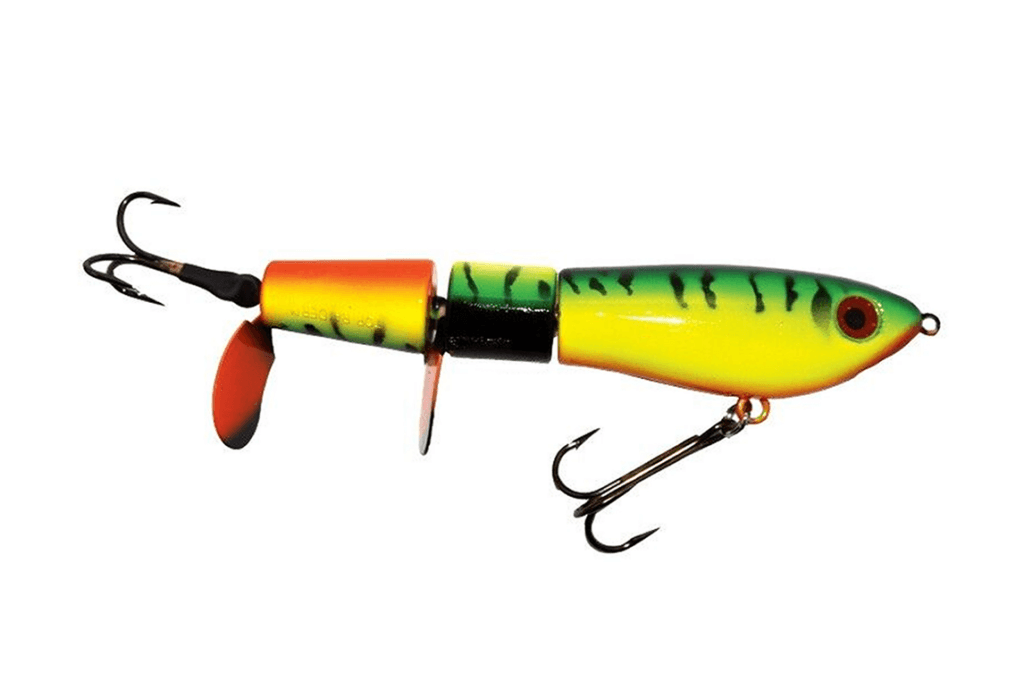
The Bucher TopRaider is a topwater lure that is highly regarded among musky anglers. It is specifically designed to create a commotion on the water’s surface, imitating a wounded or struggling prey fish, which can trigger aggressive strikes from musky.
The TopRaider features a large, concave face that creates a noisy and splashy disturbance when retrieved across the water’s surface. This action mimics a baitfish in distress, attracting the attention of musky and provoking them to strike.
To use the Bucher TopRaider for musky fishing, cast it out and retrieve it with a steady, consistent motion. The lure’s design and shape allow it to make a wide “S” or “V” pattern on the water, which increases its visibility and draw for musky.
The TopRaider comes in various sizes and color patterns, allowing anglers to match the local musky’s preferences and the fishing conditions. It is commonly used in larger sizes to target trophy-sized musky.
When fishing with the Bucher TopRaider, it is important to use heavy-duty tackle and a strong fishing line to handle the powerful strikes and potential fights with musky. Proper handling and safe hook removal are crucial when catching and releasing musky.
The Bucher TopRaider is specifically designed for musky but can also attract other predatory fish species, such as pike and large bass. It is most effective in shallow areas, near weed beds, or in areas where musky are known to hunt and ambush their prey.
| Advantages | Disadvantages |
| Surface Action: The Bucher TopRaider is a surface lure designed to create a commotion on the water’s surface. It features rotating blades or props that create a lot of noise and disturbance, mimicking the movement of fleeing baitfish. This surface action can attract aggressive strikes from muskie and other predatory fish. Visual Attraction: The rotating blades and props of the Bucher TopRaider produce flashes of light and water spray, which can be highly visible to fish. The combination of movement, noise, and visual appeal makes this lure highly enticing and can help draw muskie from a distance. Versatility: The Bucher TopRaider is versatile in terms of its speed and retrieve. Anglers can vary the speed of the retrieve to imitate different prey behaviors or trigger reactions from muskie. It can be worked fast or slow, allowing anglers to adapt to different fishing conditions and fish activity levels. Durability: The Bucher TopRaider is typically built to be sturdy and withstand the aggressive strikes and powerful jaws of muskie. It is constructed from durable materials like hard plastic or wood, which can endure repeated use and resist damage. | Limited Depth Range: The Bucher TopRaider is primarily a surface lure, and its design is optimized for fishing near or on the water’s surface. It may not be as effective at deeper depths or in situations where muskie are holding in deeper water. Hooking Difficulties: Surface lures like the Bucher TopRaider often have exposed treble hooks. While this increases the chances of hooking fish, it can also lead to increased instances of hooking into vegetation, snags, or even the fish itself in some cases. Anglers need to be mindful of potential tangling or fouling when using this lure. Target Species: The Bucher TopRaider is specifically designed for muskie fishing and may not be as effective for other fish species. While it can attract large pike and bass as well, its size and surface action may not be as enticing to smaller or less aggressive fish. Learning Curve: The proper retrieve technique for the Bucher TopRaider can take some practice to master. Anglers need to learn how to work the lure to create the desired surface action and entice strikes from muskie. Beginners may need to invest time in refining their technique. |
Mepps Musky Killer
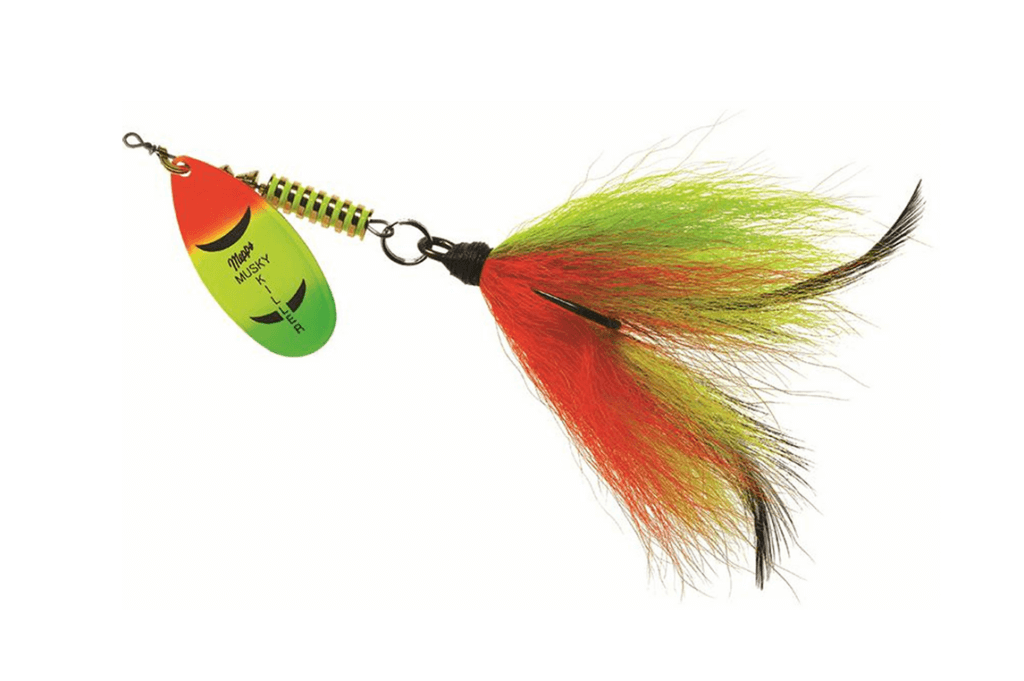
The Mepps Musky Killer is a popular lure among musky anglers. It is specifically designed to target and entice musky, one of the largest predatory fish species in freshwater.
The Musky Killer features a large, flashy blade that spins and creates vibrations in the water when retrieved. This spinning action combined with the lure’s bright colors and lifelike appearance attracts the attention of musky and triggers their predatory instincts.
To use the Mepps Musky Killer for musky fishing, cast it out and retrieve it with a steady, consistent motion. The blade’s rotation and flash, along with the lure’s erratic swimming action, imitate a wounded or fleeing baitfish, enticing musky to strike.
The Musky Killer comes in various sizes and color patterns, allowing anglers to match the local musky’s preferences and the fishing conditions. It is commonly used in larger sizes to target trophy-sized musky.
When fishing with the Mepps Musky Killer, it is important to use heavy-duty tackle and a strong fishing line to handle the powerful strikes and potential fights with musky. Proper handling and safe hook removal are crucial when catching and releasing musky.
The Musky Killer is specifically designed for musky, but it can also attract other predatory fish species, such as pike and large bass. It is suitable for fishing in lakes, rivers, and reservoirs where musky are known to inhabit.
| Advantages | Disadvantages |
| Versatility: The Mepps Musky Killer is a versatile lure that can be used in various fishing conditions and water types. It can be effective in both clear and murky waters and is designed to target muskie, pike, and other predatory fish. Lifelike Appearance: The Musky Killer is designed to mimic the appearance of a small baitfish, with its colorful skirt, realistic body shape, and lifelike tail. This lifelike presentation can attract the attention of muskie and trigger strikes. Spinner Action: The Musky Killer features a spinner blade that spins and creates vibrations as it moves through the water. This spinner action adds flash, noise, and vibration to the lure, making it highly attractive to muskie and other predators. Durability: Mepps lures are generally known for their durability, and the Musky Killer is no exception. It is typically built with quality materials, such as sturdy wire and durable hooks, which can withstand the aggressive strikes and sharp teeth of muskie. | Limited Depth Range: The Musky Killer is primarily a shallow-running lure, suitable for fishing in shallow to medium depths. It may not be as effective in deeper water or situations where muskie are holding in deeper areas. Hooking Difficulties: The Musky Killer is equipped with treble hooks, which can increase the chances of hooking fish. However, it may also lead to increased instances of hooking into vegetation, snags, or even the fish itself. Anglers need to be mindful of potential tangling or fouling when using this lure. Retrieval Speed: The Musky Killer may require a specific retrieval speed to achieve its optimal action and attract fish. Finding the right speed can sometimes be a trial-and-error process, and it may take some time for anglers to determine the most effective retrieval speed for their fishing conditions. Target Species: The Musky Killer is primarily designed for muskie fishing and may not be as effective for other fish species. While it can attract pike and bass as well, its size and action may not be as enticing to smaller or less aggressive fish. |
Grandma Lures
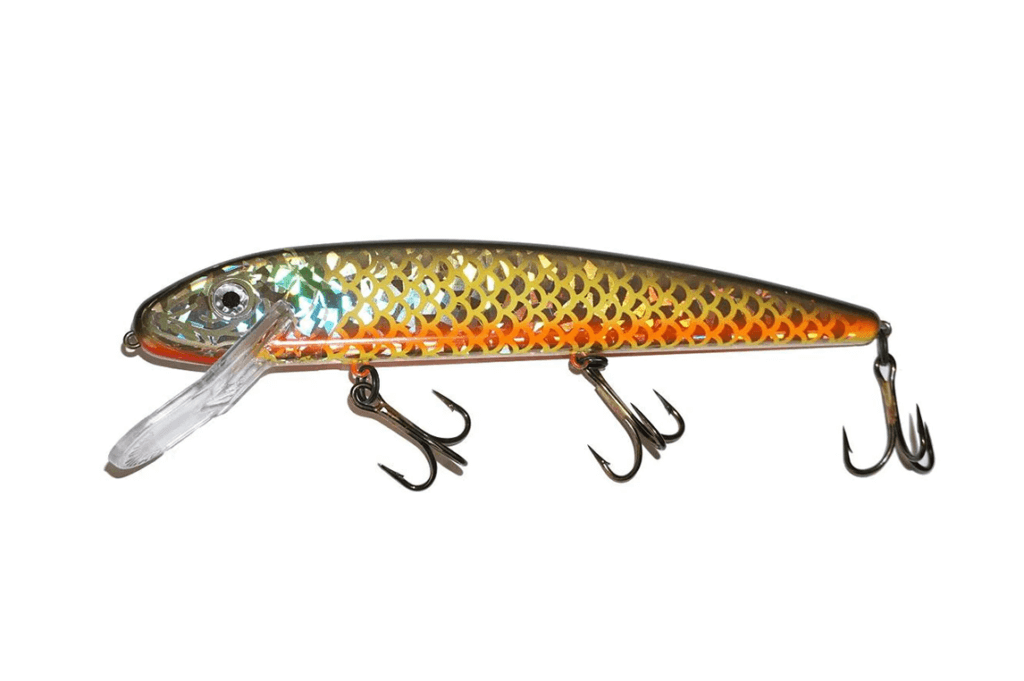
Grandma Lures are widely recognized and highly effective lures for targeting musky, known for their big size and aggressive strikes. These lures have a reputation for triggering the predatory instincts of musky, enticing them to strike with ferocity.
Grandma Lures typically feature a large, jointed body with a diving lip that allows the lure to dive and swim at varying depths. The lifelike action and movement of the lure imitate a wounded or fleeing baitfish, making it a tempting target for musky.
To use Grandma Lures for musky fishing, cast them out and retrieve them with a combination of steady reeling, jerking, and pauses. This erratic and unpredictable action can entice musky to strike, as they are known to be drawn to fast-moving prey.
Grandma Lures come in a variety of sizes and color patterns, allowing anglers to match the local musky’s preferences and the fishing conditions. They are commonly used in larger sizes to target trophy-sized musky.
When fishing with Grandma Lures, it is important to use heavy-duty tackle and a strong fishing line to handle the powerful strikes and potential fights with musky. Proper handling and safe hook removal are crucial when catching and releasing musky.
Grandma Lures are specifically designed for musky but can also attract other predatory fish species, such as pike and large bass. They are most effective when fished in areas with structure and cover, such as weed beds, rock formations, or submerged timber, where musky are known to hide and ambush their prey.
| Advantages | Disadvantages |
| Realistic Action: Grandma Lures are designed to mimic the swimming action of a distressed baitfish. They have a jointed construction that allows for a lifelike movement in the water, which can be highly enticing to muskie and pike. Durability: Grandma Lures are typically built to be durable and withstand the aggressive strikes and sharp teeth of muskie and pike. They are made from tough materials like hard plastic or wood, which can endure repeated use and resist damage. Versatility: Grandma Lures can be used in various fishing conditions and water types. They can be effective in both shallow and deep waters, making them suitable for different fishing scenarios. They can also be retrieved at different speeds to match the fish’s activity level. Attractive Design: Grandma Lures often feature vibrant colors, intricate patterns, and realistic eyes that add to their visual appeal. Their eye-catching appearance can help grab the attention of muskie and pike, increasing the chances of attracting strikes. | Learning Curve: Using Grandma Lures effectively may require some practice and experimentation. Anglers need to learn how to manipulate the lure to achieve the desired swimming action and provoke strikes from muskie and pike. It may take time to develop the right technique and retrieve style. Limited Depth Range: While Grandma Lures can be effective in both shallow and deep waters, their jointed construction and buoyancy may limit their diving capabilities. They may not be as suitable for targeting fish holding in extremely deep water or at specific depths. Hooking Difficulties: Grandma Lures typically come with treble hooks, which can increase the chances of hooking fish. However, they may also lead to increased instances of hooking into vegetation, snags, or even the fish itself. Anglers need to be cautious and mindful of potential tangling or fouling when using these lures. Target Species: Grandma Lures are primarily designed for muskie and pike fishing and may not be as effective for other fish species. Their size, action, and predatory fish-specific design may not be as enticing to smaller or less aggressive fish. |
Believer
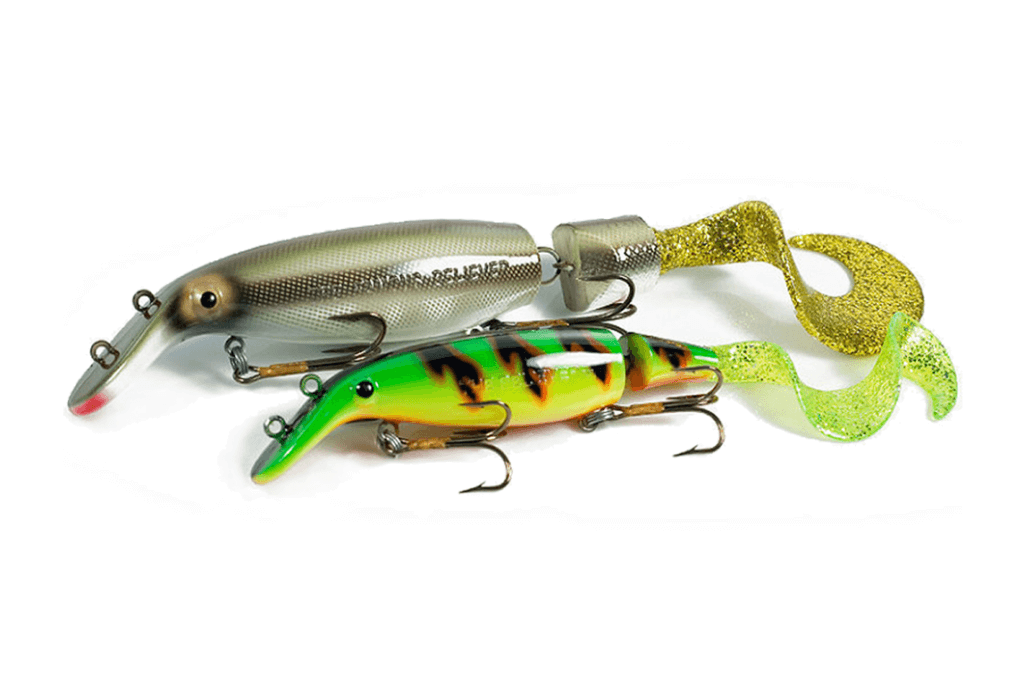
The Believer lure is a highly regarded and versatile lure for musky fishing. It is known for its ability to trigger aggressive strikes from musky, making it a popular choice among musky anglers.
The Believer lure typically features a large, jointed body with a lifelike swimming action. It is designed to imitate a wounded or fleeing baitfish, which can entice musky to strike. The lure’s jointed body allows for fluid and realistic movement in the water, making it highly effective in attracting musky.
To use the Believer lure for musky fishing, cast it out and retrieve it with a combination of steady reeling, jerking, and pauses. This erratic and unpredictable action can mimic the behavior of injured prey, drawing the attention of musky and triggering their predatory instincts.
The Believer lure comes in various sizes and color patterns, allowing anglers to match the local musky’s preferences and the fishing conditions. It is commonly used in larger sizes to target trophy-sized musky.
When fishing with the Believer lure, it is important to use heavy-duty tackle and a strong fishing line to handle the powerful strikes and potential fights with musky. Proper handling and safe hook removal are crucial when catching and releasing musky.
The Believer lure is specifically designed for musky but can also attract other predatory fish species, such as pike and large bass. It is most effective when fished in areas with structure and cover, such as weed beds, rock formations, or submerged timber, where musky are known to hide and ambush their prey.
| Advantages | Disadvantages |
| Versatility: The Believer lure is a versatile bait that can be used in various fishing conditions and water types. It can be effective in both shallow and deep waters, making it suitable for different fishing scenarios. Realistic Appearance: The Believer lure is designed to imitate the appearance and movement of a wounded baitfish. It often features a natural color pattern, lifelike eyes, and a realistic swimming action that can attract muskie and other predatory fish. Durable Construction: Believer lures are typically built to be durable and withstand the aggressive strikes and sharp teeth of muskie. They are commonly made from tough materials like hard plastic or wood, which can endure repeated use and resist damage. Wide Range of Sizes and Colors: Believer lures come in various sizes and color patterns, allowing anglers to match the baitfish species found in their fishing area. This versatility in size and color selection increases the chances of attracting muskie and other predators. | Learning Curve: Like many muskie lures, the Believer lure requires a specific technique to maximize its effectiveness. Anglers need to learn how to manipulate the lure to create the desired action and mimic the movement of baitfish. It may take practice and experimentation to master the retrieve technique. Limited Depth Range: While the Believer lure can be effective in both shallow and deep waters, its diving capabilities may have limitations. It may not be as suitable for targeting fish holding in extremely deep water or at specific depths. Hooking Difficulties: Believer lures typically come with treble hooks, which can increase the chances of hooking fish. However, they may also lead to increased instances of hooking into vegetation, snags, or even the fish itself. Anglers need to be cautious and mindful of potential tangling or fouling when using these lures. Target Species: The Believer lure is primarily designed for muskie fishing and may not be as effective for other fish species. Its size, action, and specific design may not be as enticing to smaller or less aggressive fish. |
Medussa
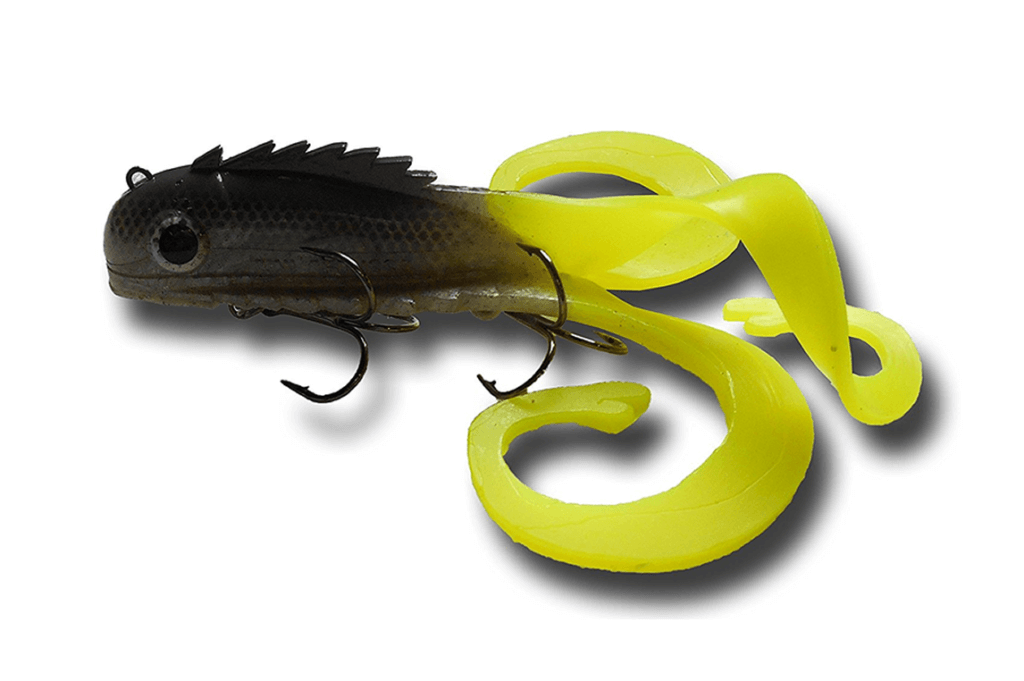
The Medussa lure is a highly specialized and unique lure designed specifically for targeting musky. It is known for its distinctive appearance and lifelike swimming action, making it a popular choice among musky anglers.
The Medussa lure features a soft plastic body with multiple flexible tails that mimic the movement of a live baitfish or a swimming eel. The tails have a pulsating action in the water, creating vibrations and attracting the attention of musky. The lure’s realistic design and lifelike action make it highly enticing to musky and increase the chances of triggering a strike.
To use the Medussa lure for musky fishing, cast it out and retrieve it with a combination of steady reeling, jerking, and pauses. This allows the lure to swim and dart in an erratic and unpredictable manner, imitating the movements of injured or fleeing prey. The Medussa’s action can be enhanced by varying the retrieval speed and incorporating pauses to simulate wounded or vulnerable baitfish.
The Medussa lure comes in various sizes and color patterns to match the local musky’s preferences and the fishing conditions. It is commonly used in larger sizes to target trophy-sized musky.
When fishing with the Medussa lure, it is important to use heavy-duty tackle and a strong fishing line to handle the powerful strikes and potential fights with musky. Proper handling and safe hook removal are crucial when catching and releasing musky.
The Medussa lure is specifically designed for musky but can also attract other predatory fish species, such as pike and large bass. It is most effective when fished in areas with structure and cover, such as weed beds, rock formations, or submerged timber, where musky are known to hide and ambush their prey.
| Advantages | Disadvantages |
| Realistic appearance: The Medusa lure is designed to resemble a snake, which can be a natural prey for many fish species. Its lifelike appearance and movement can attract predatory fish and trigger their feeding instincts. Versatility: Medusa lures can be used for various types of fishing, including freshwater and saltwater fishing. They are effective for targeting a wide range of species, such as bass, pike, muskie, snook, and redfish. Action and vibration: The design of the Medusa lure includes flexible segments or joints that create a lifelike swimming action. This action produces vibrations in the water, which can attract fish from a distance and entice them to strike. Weedless design: Many Medusa lures come with a weedless design, featuring hooks that are hidden or protected by the lure’s body. This design allows anglers to fish in areas with heavy vegetation or cover without getting snagged, increasing the chances of hooking fish. | Limited effectiveness in certain conditions: While Medusa lures can be highly effective, their performance may vary depending on the fishing conditions. In situations where fish are not actively feeding or when they prefer other types of prey, the Medusa lure may not yield the desired results. Complexity: Medusa lures typically have multiple joints and segments, which can make them more complex to use compared to simpler lures. Achieving the proper action and presentation requires practice and skill. Price: Medusa lures can be relatively more expensive compared to other types of lures. Their intricate design and construction contribute to their higher cost. Losing or damaging a Medusa lure can be a financial setback. Limited target species: While Medusa lures can attract a wide range of predatory fish, they may not be as effective for species that don’t typically prey on snakes or snake-like creatures. If you’re targeting fish that primarily feed on smaller baitfish or insects, other lure types may be more suitable. |
Phantom Softail
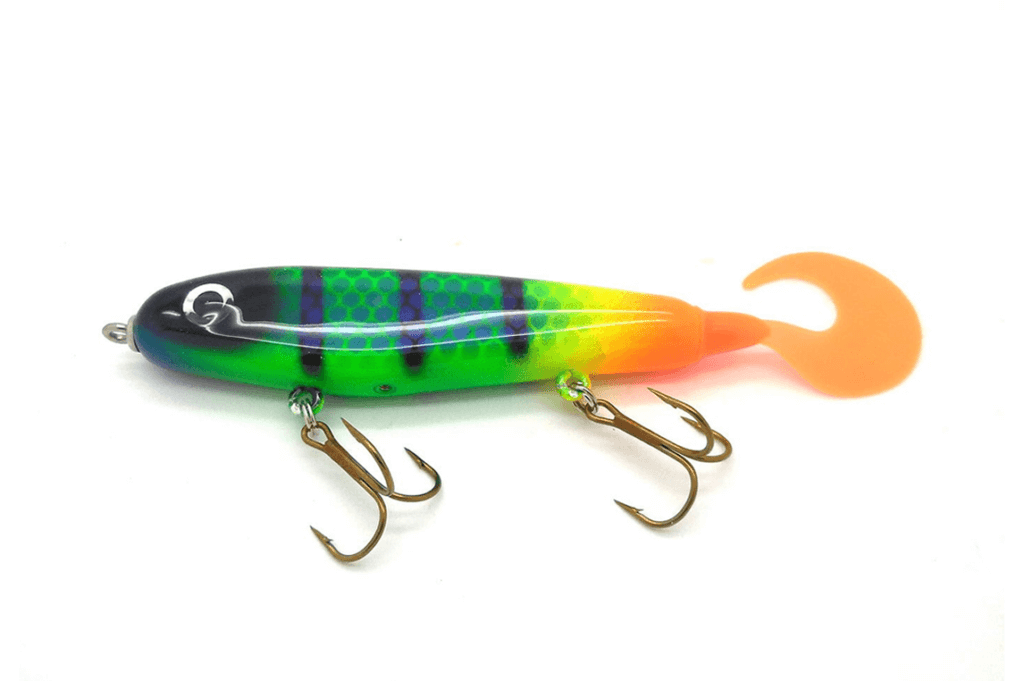
The Phantom Softail lure is a popular choice among musky anglers for its realistic appearance and lifelike swimming action. It is specifically designed to mimic the movements of a wounded baitfish, making it highly effective in triggering strikes from musky.
The Phantom Softail lure features a soft plastic body with a jointed design that allows for fluid and natural movement in the water. The lure is typically equipped with multiple treble hooks strategically positioned to increase hooking efficiency and secure a strong hold on the musky.
When fishing with the Phantom Softail lure, it is important to cast it out and retrieve it with a steady and rhythmic motion. The lure’s jointed body creates a realistic swimming action as it moves through the water, imitating the vulnerable movements of an injured baitfish. Varying the retrieval speed, incorporating pauses, or adding occasional twitches can further enhance the lure’s appeal and entice musky to strike.
The Phantom Softail lure comes in various sizes and color patterns to match the local forage and fishing conditions. It is commonly used in larger sizes to target trophy-sized musky. It is recommended to use heavy-duty fishing tackle and a strong fishing line to handle the powerful strikes and potential fights with musky.
When targeting musky with the Phantom Softail lure, it is important to fish in areas known to hold musky, such as weed beds, rocky structures, or submerged timber. These areas provide cover and ambush points where musky are likely to be found. Patience and persistence are key when fishing for musky, as they can be elusive and require strategic presentation to entice a strike.
| Advantages | Disadvantages |
| Realistic appearance: Phantom Softail lures are often crafted to closely resemble the natural appearance of baitfish, with lifelike colors, patterns, and body shapes. This realism can attract predatory fish species and entice them to strike. Lifelike action: The design of Phantom Softail lures allows for a realistic swimming action in the water. They often have soft, flexible bodies that produce a lifelike movement, mimicking the swimming motion of real baitfish. This action can make them highly effective in triggering strikes from fish. Versatility: Phantom Softail lures can be effective for a wide range of fish species, including bass, pike, musky, walleye, and more. Their versatility makes them suitable for various fishing environments such as freshwater lakes, rivers, and even inshore saltwater. Durability: Many Phantom Softail lures are constructed with durable materials, such as soft plastic bodies and strong hooks. This durability allows them to withstand the wear and tear of fishing, making them long-lasting and cost-effective. | Skill required: Like any fishing lure, using a Phantom Softail effectively requires some skill and technique. The angler needs to learn how to properly manipulate the lure to create a realistic swimming action and to present it in a way that entices fish to strike. It may take some practice to master the necessary skills. Limited effectiveness in certain situations: While Phantom Softail lures can be effective in many fishing scenarios, there may be situations where other lures or bait are more suitable. For example, if fish are feeding on specific prey items that differ from the baitfish imitation of the Phantom Softail, other lures or techniques may yield better results. Cost: Depending on the brand and quality, Phantom Softail lures can be relatively expensive compared to other types of fishing lures. This cost may deter some anglers, especially those who are on a tight budget or prefer more affordable options. Vulnerability to damage: While many Phantom Softail lures are designed to be durable, they can still be susceptible to damage from sharp teeth, aggressive strikes, or rough underwater structures. It’s important to inspect the lure regularly and replace damaged or worn-out parts to maintain its effectiveness. |
Weagle
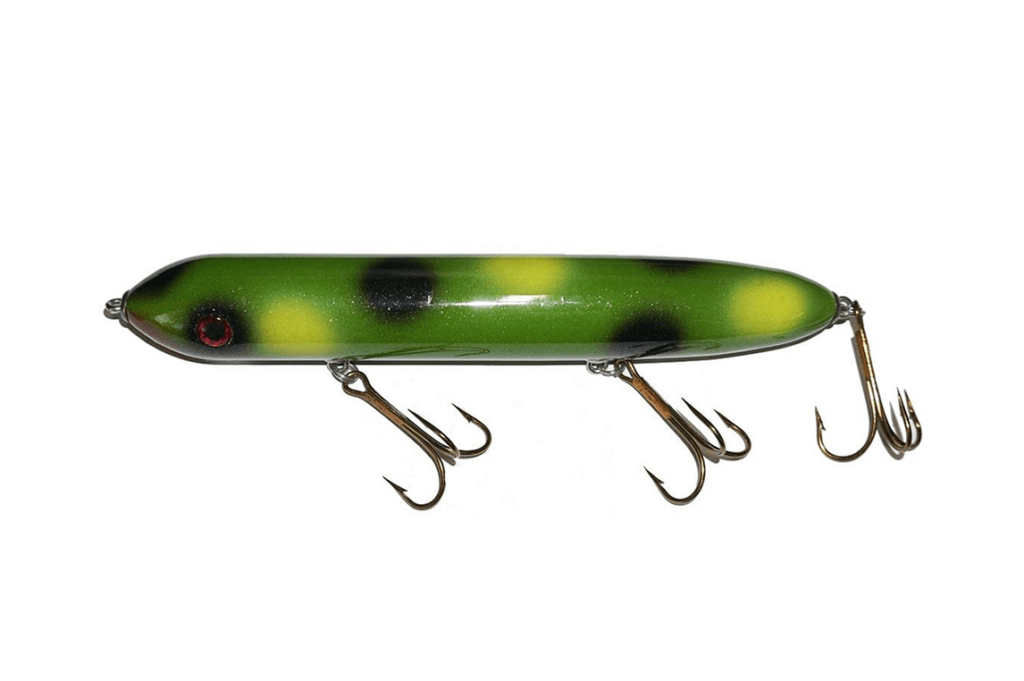
The Weagle lure is a popular choice among musky anglers due to its unique design and effective topwater action. It is specifically designed to imitate a wounded or struggling baitfish on the water’s surface, making it a highly enticing target for musky.
The Weagle lure features a propeller on the front end, which creates a commotion and splashing sound as it spins through the water. This action mimics the sound and disturbance caused by a distressed baitfish, attracting the attention of musky. The lure also has a diving lip that helps it stay on the water’s surface and creates a subtle popping action as it’s retrieved.
When fishing with the Weagle lure for musky, it is important to cast it out and retrieve it with a combination of steady reeling and occasional twitches. The propeller on the front will create a loud splash and sputtering noise, simulating a struggling baitfish on the surface. This action can trigger aggressive strikes from musky, especially during low-light conditions or when targeting active feeding fish.
The Weagle lure is typically used in larger sizes to match the size of musky and provide a more enticing target. It is recommended to use heavy-duty fishing tackle and a strong fishing line to handle the powerful strikes and potential fights with musky.
When targeting musky with the Weagle lure, focus on areas with weed beds, submerged structures, or near drop-offs where musky are likely to be lurking. These areas provide cover and ambush points for musky to attack their prey. Experiment with different retrieval speeds and cadences to find the most effective presentation for the day’s fishing conditions.
| Advantages | Disadvantages |
| Realistic Action: Weagle lures are designed to mimic the natural movement of injured or distressed prey. They have a unique wobbling or walking action on the water’s surface, which can be very enticing to fish, especially those that are accustomed to feeding on surface insects or small baitfish. Topwater Attraction: Weagle lures excel at drawing strikes from fish that feed near the water’s surface. The commotion created by the lure’s action, combined with the splashes and ripples it produces, can trigger aggressive strikes from predatory fish. Versatility: Weagle lures can be effective in various fishing conditions, such as calm or slightly choppy water. They can be worked in different ways, including a steady retrieve, twitching, or pausing, allowing anglers to experiment and find the most effective presentation for the prevailing conditions. Visual Appeal: The colorful and detailed design of Weagle lures can catch the attention of fish from a distance. Their realistic appearance, combined with the action, can elicit strikes even from wary fish. | Limited Depth Range: Weagle lures are primarily designed for fishing on the water’s surface. They are not effective for fishing deeper water columns or targeting fish that are holding at specific depths. If the fish are not actively feeding near the surface, Weagle lures may not produce the desired results. Weather and Water Conditions: While Weagle lures can work well in calm or slightly choppy water, they may struggle in extremely windy conditions or when the water is rough. Strong winds can make it challenging to control the lure’s action and accuracy, potentially reducing its effectiveness. Species and Location Specific: Weagle lures tend to be most effective for bass and other similar species that feed near the surface. If you’re targeting fish that primarily inhabit deeper water or have different feeding habits, such as bottom-feeding fish, using a Weagle lure may not be the best choice. Learning Curve: Mastering the presentation and retrieve techniques required for Weagle lures can take some practice. It may require experimenting with different speeds, pauses, and twitches to find the most successful approach. Beginners might initially struggle to achieve the desired action and attract fish effectively. |
Shallow Invader
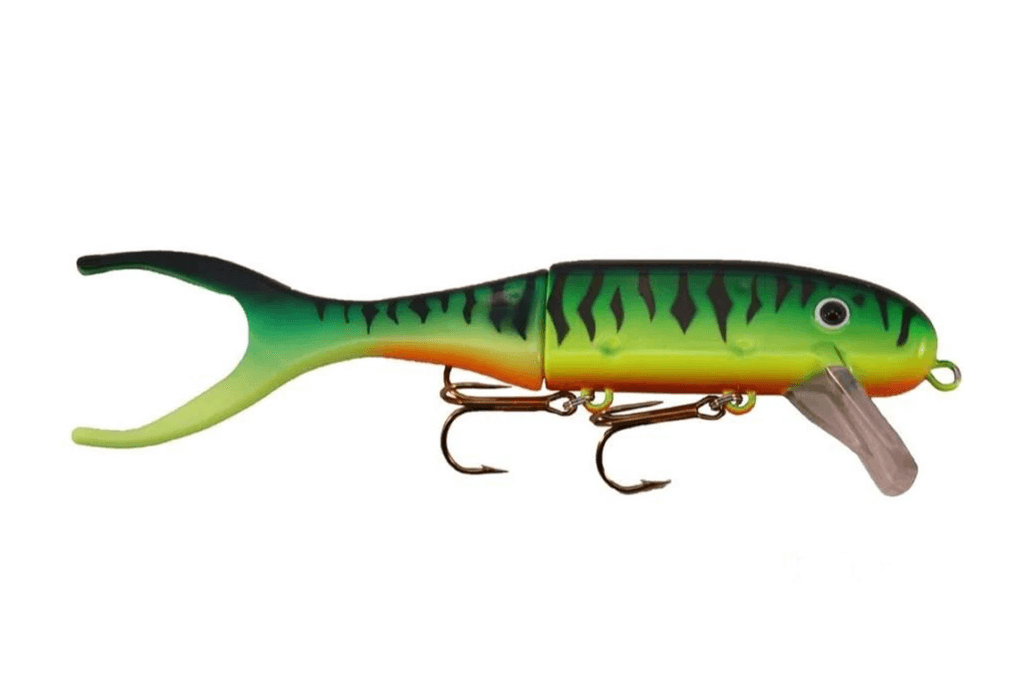
The Shallow Invader lure is a popular choice among musky anglers for targeting musky in shallow water. It is specifically designed to run at shallow depths, making it effective for fishing over weed beds, rocky areas, and other shallow structures where musky are known to be present.
The Shallow Invader lure features a long, slender body with a diving lip that allows it to swim just below the water’s surface. It has a lifelike swimming action that mimics the movement of a wounded baitfish or a fleeing prey, which is highly attractive to musky. The lure is typically equipped with multiple treble hooks to increase the chances of hooking a musky when it strikes.
To fish the Shallow Invader for musky, cast it out and retrieve it at a medium to fast pace. The lure’s action will cause it to swim with an erratic side-to-side motion, imitating the movements of an injured or fleeing baitfish. It is often effective to incorporate pauses and twitches into the retrieve to further entice musky and trigger strikes.
The Shallow Invader lure comes in a variety of color patterns to mimic different baitfish species and match the local forage of the musky’s habitat. It is important to experiment with different colors and retrieve speeds to determine the most effective presentation for the specific fishing conditions.
When fishing with the Shallow Invader lure, it is recommended to use heavy-duty fishing tackle and a strong fishing line to handle the powerful strikes and potential fights with musky. Proper handling and safe hook removal are crucial when catching and releasing musky.
| Advantages | Disadvantages |
| Shallow-water Performance: Shallow Invader lures are specifically designed to operate effectively in shallow water environments, such as weedy areas, rocky shorelines, and shallow flats. They have a shallow diving depth, typically ranging from a few inches to a few feet, allowing anglers to target fish that are holding in these areas. Weedless Design: Shallow Invader lures often feature a weedless design, incorporating features like single or double hooks that are positioned close to the body or hidden in a recessed manner. This design reduces the chances of the lure getting snagged in vegetation or other underwater obstacles, making it ideal for fishing in weedy areas. Versatility: Shallow Invader lures can be effective in a variety of fishing conditions, including both calm and slightly choppy water. They can be worked in different ways, such as a slow and steady retrieve, a twitching and pausing action, or a jerkbait-style motion, providing anglers with versatility in their presentations. Attractive Action: These lures typically have a jointed or segmented body design that imparts a lifelike swimming action in the water. The wobbling, rolling, or darting motion can trigger predatory instincts in fish, enticing them to strike. | Limited Depth Range: As the name suggests, Shallow Invader lures are specifically designed for fishing in shallow water. If the fish you’re targeting are holding in deeper water or at specific depths, these lures may not be effective. They are not suitable for deepwater fishing scenarios. Limited Species Appeal: While Shallow Invader lures are known for being effective for musky and pike, they may have limited success with other species that primarily inhabit deeper water or have different feeding habits. If you’re targeting species that primarily feed near the bottom or in mid-depth ranges, alternative lures might be more suitable. Learning Curve: Achieving the desired action and presentation with Shallow Invader lures may require some practice and experimentation. Anglers need to learn the right retrieval techniques, such as varying the speed, imparting twitches, or incorporating pauses, to trigger strikes from fish. Beginners might need time to familiarize themselves with these techniques. Size and Weight: Shallow Invader lures tend to be larger and heavier compared to other fishing lures. While this can be advantageous for targeting musky and pike, it can also make casting and working the lure more physically demanding. It might require a heavier rod and appropriate tackle to handle these lures effectively. |

